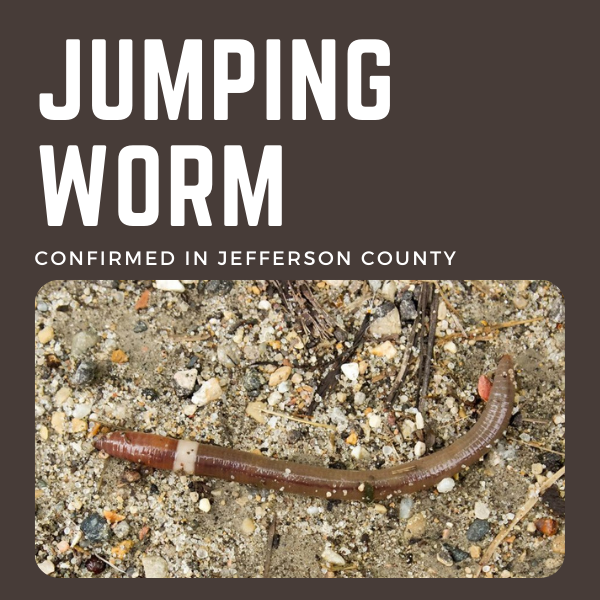This article was featured in the 2022 Spring Newsletter by Sue Gwise-CCE Jefferson County.
The invasive jumping worm (JW) has been confirmed in Jefferson County. In November a suspicious worm sample that was brought into CCE Jefferson was sent to Colgate University for positive identification. This destructive earthworm was first found in the SLELO PRISM region in St. Lawrence County in 2018. Jumping worms create an ecological disaster by rapidly consuming all the organic matter in the soil. This leaves behind a soil that looks like coffee grounds, is devoid of nutrients, and is highly susceptible to erosion. Worst of all there is no control.
Wormy Background:
All the worms that inhabit the soils in the northern portions of North America are NOT native. Any ‘native’ worms were scoured away by glaciers. Upon colonization, worms were introduced from Europe. They were brought over in plants, or in soil that was used as ship ballast. Even though these foreign worms were not native, they are beneficial and well-behaved. They aerate and break up the soil, stimulate microbial activity, and break down plant residue. All this happens in a balanced manner and nutrients are cycled slowly throughout the ecosystem. The term ‘jumping worm’ collectively refers to several species of worms introduced from the Orient. In comparison to European worms, JW behaves very differently. They live at much higher densities than European worms and have a high reproductive rate. They can reproduce via parthenogenesis, a process by which a female can produce female offspring without a male. That means that if just one worm is introduced to a site it can give rise to an entire population. These voracious worms consume the organic matter in soils much quicker than European worms. This interferes with nutrient cycling and eventually leads to less regeneration in forests and a decrease in biodiversity across all trophic levels. The degraded soil is not habitable for most plants. Jumping worms are also toxic to birds, amphibians, and other worms. Although some animals such as raccoons, chipmunks, squirrels, opossum, and moles will consume JW.
Identification:
Also known as ‘crazy snake worms’ or ‘Alabama jumpers’ the worms will thrash about wildly when disturbed. They can also detach their tails when handled. They range from 1.5 to 8 inches in length. Jumping worms have a smooth, white-colored clitellum (the narrow collar found around the body of most earthworms) as opposed to European worms which have a raised pink-red clitellum. All other characteristics are subjective, making identification difficult.

Life Cycle:
Adult jumping worms do not overwinter in New York- the adults die once subjected to frost. The next generation passes the winter in small (poppy seed-sized) white cocoons that are hardy to minus 40 degrees. Worms emerge in the spring and become mature in 70 to 90 days. At that point, they can produce new cocoons. There are two generations per year versus European worms that only have one generation per year.
What to do:
As mentioned, there are no controls for jumping worms. If you are suspicious that your soil is infested, mix 1/3 cup of ground mustard with one gallon of water and pour it slowly over the soil. This will irritate any worms and bring them to the surface (this is a sampling method, not a control method; it will not harm plants or beneficial earthworms). You can then look for any jumping worms and bring suspicious samples to your local extension office for identification.
To minimize the spread of AJW:
- Do NOT buy or use jumping worms for bait, vermicomposting, or gardening.
- Only purchase or trade compost that was heated to appropriate temperatures and duration following protocols for reducing pathogens.
- Clean compost, soil, and debris from vehicles, personal gear, equipment, and gardening tools before moving to and from sites.
- Be careful when sharing and moving plants. Always check for worms and know where your plantings come from. Buy bare root stock when possible.
- Dispose of all live worms in the trash or place them in a bag and leave them out in the sun for at least 10 minutes. Then throw the bag away.
If you find jumping worms, follow these steps:
- Note the location.
- Take a clear, up-close photo showing the clitellum (band around the body).
- If possible, collect a specimen to show an expert.
- Report to NYiMapInvasives.org, and your local Cornell Cooperative Extension.
- For more resources visit our invasive species profile page

To minimize the spread of AJW:
- Do NOT buy or use jumping worms for bait, vermicomposting, or gardening.
- Only purchase or trade compost that was heated to appropriate temperatures and duration following protocols for reducing pathogens.
- Clean compost, soil, and debris from vehicles, personal gear, equipment, and gardening tools before moving to and from sites.
- Be careful when sharing and moving plants. Always check for worms and know where your plantings come from. Buy bare root stock when possible.
- Dispose of all live worms in the trash or place them in a bag and leave them out in the sun for at least 10 minutes. Then throw the bag away.


